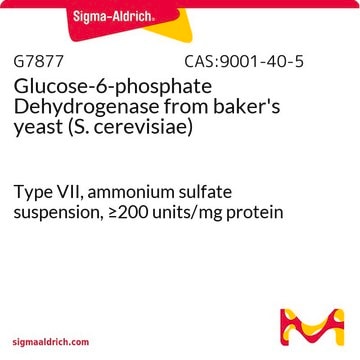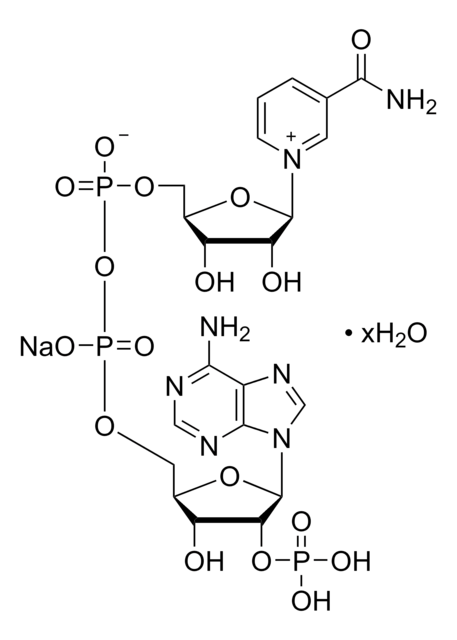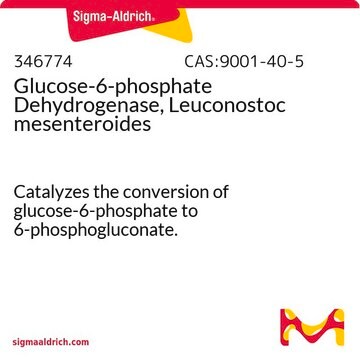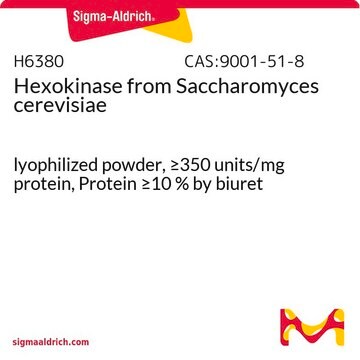추천 제품
유형
Type IX
Quality Level
양식
lyophilized powder
특이 활성도
200-400 units/mg protein (modified Warburg-Christian)
분자량
128 kDa
β-NADP 및 β-NADPH 함량
≤10 mmol/mol
응용 분야
agriculture
배송 상태
dry ice
저장 온도
−20°C
유사한 제품을 찾으십니까? 방문 제품 비교 안내
일반 설명
Research area: Cell Signaling
Glucose-6-phosphate dehydrogenase (G6PD) is a key metabolic enzyme of the pentose phosphate pathway. In S. cerevisiae, it is encoded by the ZWF1 gene. G6PD exists as a tetramer in its active form.
Glucose-6-phosphate dehydrogenase (G6PD) is a key metabolic enzyme of the pentose phosphate pathway. In S. cerevisiae, it is encoded by the ZWF1 gene. G6PD exists as a tetramer in its active form.
애플리케이션
Glucose-6-phosphate dehydrogenase is used:
- To test ketose reductase activity in developing maize endosperm.
- For recycling microassay of β-NADP and β-NADPH.
- To measure the intracellular levels of NADPH and total NADP.
- To measure the nicotinamide adenine dinucleotide (NAD) kinase kinetic assay activity.
생화학적/생리학적 작용
Glucose-6-phosphate dehydrogenase catalyzes the conversion of glucose-6-phosphate to 6-phosphogluconolacetone as the first step in the pentose phosphate pathway.
Glucose-6-phosphate dehydrogenase catalyzes the rate-limiting step in the pentose phosphate pathway. Its function involves the conversion of glucose-6-phosphate to 6-phosphogluconolacetone while generating NADPH, which is essential for the regeneration of glutathione The glutathione system utilizes nicotinamide adenine dinucleotide phosphate hydrogen (NADPH) to effectively eliminate excess hydrogen peroxide. Glucose-6-phosphate dehydrogenase (G6PD) plays an important role in regulating cell growth and survival. Their levels are higher in cells undergoing normal and neoplastic growth. Increased glucose-6-phosphate dehydrogenase activity plays a pivotal role in preventing reactive oxygen species mediated cell death. Glucose-6-phosphate dehydrogenase is over expressed in several cancers whereas its activity is reduced in hyperglycemia. A deficiency in glucose-6-phosphate dehydrogenase causes hemolysis.
단위 정의
One unit will oxidize 1.0 μmole of D-glucose 6-phosphate to 6-phospho-D-gluconate per min in the presence of NADP at pH 7.4 at 25 °C.
물리적 형태
Lyophilized powder essentially sulfate-free, containing approx. 20% sodium citrate
신호어
Danger
유해 및 위험 성명서
예방조치 성명서
Hazard Classifications
Resp. Sens. 1
Storage Class Code
11 - Combustible Solids
WGK
WGK 3
Flash Point (°F)
Not applicable
Flash Point (°C)
Not applicable
개인 보호 장비
Eyeshields, Gloves, type N95 (US)
가장 최신 버전 중 하나를 선택하세요:
시험 성적서(COA)
Lot/Batch Number
이미 열람한 고객
The global prevalence of glucose-6-phosphate dehydrogenase deficiency: A systematic review and meta-analysis
Nkhoma ET and Poole C
Blood Cells, Molecules and Diseases, 42, 267?278-267?278 (2009)
The Pentose Phosphate Pathway in Yeasts-More Than a Poor Cousin of Glycolysis
Bertels LK, et al.
Biomolecules, 11(5), 725-725 (2021)
Impact of glucose-6-phosphate dehydrogenase deficiency on the pathophysiology of cardiovascular disease
Hecker PA, et al.
American Journal of Physiology. Heart and Circulatory Physiology, 304(4), H491-H500 (2013)
Glucose-6-phosphate dehydrogenase, NADPH, and cell survival
Stanton R C
IUBMB Life, 64(5), 362-369 (2012)
Actin cytoskeleton vulnerability to disulfide stress mediates disulfidptosis
Liu X, et al.
Nature Cell Biology, 25(3), 404-414 (2023)
프로토콜
Measure hexokinase activity using a continuous spectrophotometric rate-determination assay at 340 nm, catalyzing D-hexose sugar phosphorylation using ATP.
To measure glucose-6-phosphate dehydrogenase activity, beta-nicotinamide adenine dinucleotide phosphate is used in a spectrophotometric rate determination assay at 340 nm.
자사의 과학자팀은 생명 과학, 재료 과학, 화학 합성, 크로마토그래피, 분석 및 기타 많은 영역을 포함한 모든 과학 분야에 경험이 있습니다..
고객지원팀으로 연락바랍니다.













